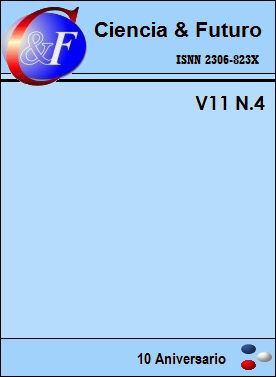Temperatures generated in a dissimile radial friction welding through finite elements
Keywords:
finite elements, temperature, heat flux, radial frictionAbstract
The objective of the work is to establish the temperatures that are generated in friction welding in AISI 316L steel bars and Cu-DHP copper by means of the finite element method (FEM). The simulation is carried out using bars of 12 mm in diameter and 100 mm in length, where the first is considered to rotate at 1200 r/m and a pressure of 30 MPa is applied. The mesh was structured with 1358 nodes and 473 meshes. It was determined that the maximum temperature is obtained at 1059 oC in the copper bar with a variation in the interface between 945,61 oC and 831,41 oC and that during the heat flow there is a decrease in the center line of the weld.Downloads
References
ALAVALA, C. 2016. Weldability of Friction Welding Process for AA2024 Alloy and SS304 Stainless Steel using Finite Element Analysis. Int. Journal of Engineering Research and Application 6(3): 53-57.
AMBROZIAK, A.; WINNICKI, M.; LASKA, P. & LACHOWICZ, M.; ZWIERZCHOWSKI, M.; LESNIEWSKI, J. 2011. Examination of friction coefficient in friction welding process of tubular steel elements. Archives of metallurgy and materials 56(4): 975-980.
ARUN, P.; NITHIN, R.; YADHU, V. & SANALKUMAR, C. 2017. To design and construct a friction welding attachment on lathe, conduct experiment and to study about mechanical behavior of friction welded joints of aluminum rods. International Journal of Engineering Research & Technology (IJERT) 6(07): 150-158.
BUFFA, G.; FRATINI, L.; PASTA, S. & SHIVPURI, R. 2008. On the thermo-mechanical loads and the resultant residual stresses in friction stir processing operations. CIRP Annals - Manufacturing Technology 57(1): 287-290.
KIMURA, M.; INOUE, H.; KUSAKA, M.; KAIZU, K. & FUJI, A. 2010. Analysis method of friction torque and weld interface temperature during friction process of steel friction welding. J. Solid Mech. Mater. Eng 4(3): 401-413.
MISHRA, R.; DE, P. S. & KUMAR, N. 2014. Friction stir processing. In Friction Stir Welding and Processing. Springer International Publishing. pp. 259-296.
MOARREFZADEH, A. 2012. Study of heat affected zone (HAZ) in friction welding process. Journal of Mechanical Engineering 1(1): 11-18.
MUMIN, S. 2016. Optimizing the parameters for friction welding stainless steel to copper Parts. Materiali in tehnologije / Materials and technology 50(1): 109-115.
PEEL, M.; STEUWER, A. & WITHERS, P. 2006. Dissimilar friction stir welds in AA5083-AA6082. Part I: process parameter effects on thermal history and weld properties. Metallurgical and Materials Transactions A 37(7): 2183-2193.
REN, S.; MA, Z. & CHEN, L. 2007. Effect of welding parameters on tensile properties and fracture behavior of friction stir welded Al–Mg–Si alloy. Scripta Materialia 56(6): 69-72.
SESHAGIRIRAO, B.; SIVARAMAKRISHNA, V. & SAIKRISHNAPRASAD, G. 2015. Experimental investigation of rotary friction welding parameters of aluminum (H-30) and mild steel (AISI-1040). International Journal of Innovative Research in Science, Engineering and Technology 4(5): 2920-2925.
SCHMICKER, D.; PERSSON, P. & STRACKELJAN, J. 2014. Implicit geometry meshing for the simulation of rotary friction welding. Journal of Computational Physics 270(115): 478-489.
SUTTON, M.; REYNOLDS, P.; WANG, D. & HUBBARD, C. 2002. Study of residual stresses and microstructure in 2024-T3 aluminum friction stir butt welds. Journal of Engineering Materials and Technology 124(2): 215.
Published
How to Cite
Issue
Section
Esta obra está bajo una Licencia Creative Commons Reconocimiento-NoComercial 4.0 Internacional
La Revista Ciencia & Futuro es una revista de acceso abierto, todo el contenido está disponible gratuitamente sin cargo para el usuario o su institución. Los usuarios pueden leer, descargar, copiar, distribuir, imprimir, buscar o vincular los textos completos de los artículos, o utilizarlos para cualquier otro fin lícito, sin pedir permiso previo al editor o al autor. Todo lo anterior, de acuerdo con la definición de BOAI de acceso abierto.
Los autores que publican en esta revista están de acuerdo con los siguientes términos: Licencia Creative Commons Atribución-NoComercial permite que el beneficiario de la licencia tenga el derecho de copiar, distribuir, exhibir y representar la obra y hacer obras derivadas para fines no comerciales siempre y cuando reconozca y cite la obra de la forma especificada por el autor o el licenciante. Los autores pueden establecer por separado acuerdos adicionales para la distribución no exclusiva de la versión de la obra publicada en la revista (por ejemplo, situarlo en un repositorio institucional o publicarlo en un libro), con un reconocimiento de su publicación inicial en esta revista. Se permite y se anima a los autores a difundir sus trabajos electrónicamente (por ejemplo, en repositorios institucionales o en su propio sitio web) antes y durante el proceso de envío, ya que puede dar lugar a intercambios productivos, así como a una citación más temprana y mayor de los trabajos publicados (Véase The Effect of Open Access) (en inglés). Lo anterior debe realizarse siempre sobre el artículo ya publicado por Ciencia & Futuro.
Los autores mantienen el control sobre la integridad de sus trabajos y el derecho a ser adecuadamente reconocidos y citados.
A los editores se les otorgan derechos no exclusivos para publicar y distribuir.



